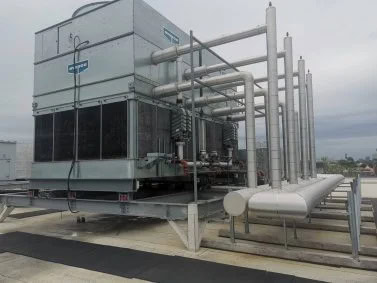Cooling towers are essential components of many air-conditioning and cooling systems. They work by dissipating the heat generated by industrial processes or air conditioning systems using a variety of cooling media. In this comprehensive guide, we'll explore in detail everything you need to know about cooling towers, including how they work, the different types, maintenance and repair, as well as tips for extending their service life.
A cooling tower is a cooling system that uses the evaporation of water to extract heat from the hot air. The hot water from the condenser is sprayed on the fans of the tower where it is cooled by evaporation. This process allows you to cool water which can then be used to cool the equipment or process that requires an effective cooling.

Cooling towers are distinguished from other cooling systems such as heat exchangers, by their ability to cool large quantities of water in a relatively short period of time. In contrast to the cooling unit (individual, a cooling tower can be used to cool multiple pieces of equipment or processes simultaneously, which makes it an effective choice for industrial applications.
The cooling towers use different technologies to cool the waterincluding evaporative cooling systems and cooling towers. Axial fans are commonly used to ensure adequate airflow through the tower, which facilitates the process of cooling. These technologies help to optimize the performance of cooling towers in ensuring an efficient cooling, and economic.
Closed-circuit cooling towers operate by cooling water within a closed circuit, minimizing water losses through evaporation. These towers are more efficient in terms of water consumption, and are often used in applications where water conservation is essential.
The towers cooling open circuit use the water from an external source to cool the equipment. The water, once used, is released into the environment, which may lead to problems of water quality due to the salts contained in it. However, these towers are often more simple and less costly to install than the towers closed circuit.
Closed-circuit cooling towers offer greater energy efficiency and a reduced environmental footprint, while open-circuit towers are easier to maintain and less costly. The choice of tower type will depend on the specific needs of each application in terms of water consumption, operating costs and durability.
Regular maintenance of the cooling towers is crucial to ensure their proper functioning and to prolong their shelf life. Proper care and maintenance to prevent performance problems, ensure energy efficiency and minimize the risk of costly breakdowns.
Problems such as corrosion, deposit build-up or water leaks can occur in cooling towers and require immediate attention. Ignoring these problems can lead to significant damage to tower components and higher repair costs in the long term.
The maintenance of cooling towers involves activities such as the cleaning of the towers, the control of filtration systems, the inspection of components and checking water levels. It is recommended to follow a preventive maintenance plan to identify and resolve potential problems before they become emergencies.
Signs of cooling tower malfunction include water leaks, reduced cooling efficiency, unusual noises or temperature fluctuations. If you observe these signs, it's advisable to have the tower professionally inspected and repaired to avoid further damage.
The current repairs of cooling towers generally consist of replacing defective components such as fans, heat exchangers or pumping systems. The repair techniques vary according to the nature of the problem and may require the intervention of specialized technicians.
The cost of cooling tower repairs depends on the severity of the problem and the parts to be replaced. It is advisable to request quotes from several suppliers to compare costs and services offered. Investing in quality repairs can extend the life of the tower and ensure optimum long-term performance.
The life of cooling towers is influenced by various factors, such as the quality of the water, the frequency of maintenance, the operating environment and the design of the tower. Effective management of these factors can contribute to prolong the sustainability and efficiency of cooling towers.
For extend the life of cooling towersit is recommended to follow a regular maintenance program, monitor, and control the quality of the cooling water, to implement management practices that are water efficient and invest in technology upgrades to improve the overall performance of the tower.
Cooling water quality is crucial to the durability of cooling towers. High levels of salts, limescale or contaminants can lead to component corrosion, blockages and long-term damage. It is essential to monitor and maintain water quality to ensure optimum tower operation over the long term.